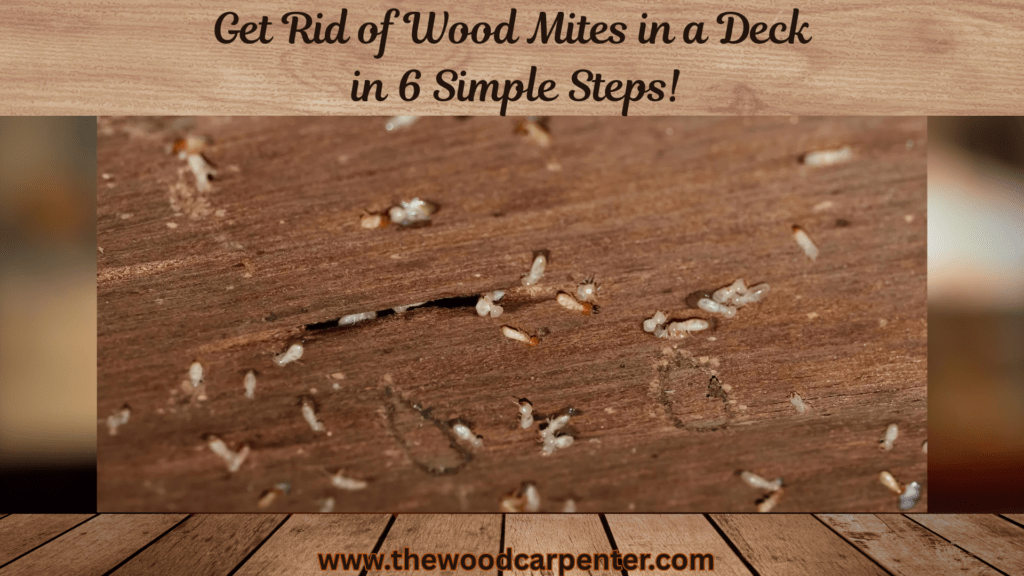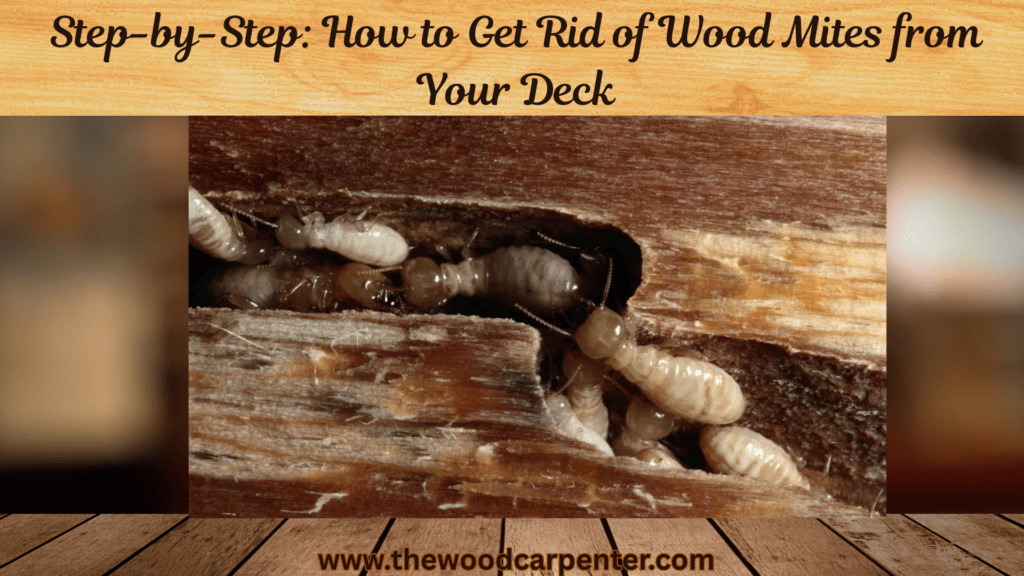
A wooden deck is a great place to relax and enjoy time outside. But sometimes, tiny bugs called wood mites can show up and cause problems. While they don’t usually harm people, they can damage your deck and become annoying if you don’t take care of them.
This guide will explain:
- What wood mites are
- How to know if you have them
- The best ways to get rid of them (naturally or with chemicals)
- Tips to prevent them from coming back
- Answers to common questions from homeowners
What Are Wood Mites?
Wood mites are a tiny bugs that look like small spiders and are often white or brown. They usually eat mold, fungi, or sometimes even parts of the wood. You might see them as little moving dots, especially in damp or shady areas of your deck.
Some types don’t do much harm, but others—especially in large numbers—can make your deck look bad and, over time, may even weaken the wood.
Key Signs of Wood Mites on Your Deck
Tiny white, brown, or translucent dots moving on the wood
- Fine, powdery dust or silk threads left behind
- Increased presence of mold or mildew in damp, shaded areas
- Occasional mild wood damage or superficial tunnels
Why Are Wood Mites on Your Deck?
Wood mites are attracted to:
Moisture: Decks that are shaded, have poor drainage, or are regularly damp are prime targets.
Mold and Fungi: Decaying plant matter, rotting wood, or unseen mold growth supplies food.
Debris and Clutter: Piled-up leaves, plant pots, and other organic matter create hidden homes.
Step-by-Step: How to Get Rid of Wood Mites from Your Deck

1. Get the Deck Ready
Clear Everything: Take off all furniture, pots, rugs, and decorations so you can clean every part of the deck.
Look for Mites: Check for small groups of moving dots, especially in damp, shady areas or where there’s mold.
2. Clean the Deck Well
Sweep Up Debris: Remove leaves, twigs, and any dirt from the surface and cracks.
Wash the Deck: Mix warm water and mild soap. Scrub the wood to remove the dirt, mold, and fungus. Rinse it off and let it dry completely—mites like moisture, so a dry deck helps keep them away.
Related article:
Top 5 Best Grass and Weed Killer
Termite Droppings: The Warning Sign You Should Never Ignore
3. Reduce Moisture
Fix Any Leaks: Repair dripping gutters, remove standing water, and trim trees or plants that block sunlight.
Add Airflow: Let the deck dry faster by improving air circulation. If needed, use a fan in spots that stay wet too long.
4. Try Natural or DIY Treatments
Essential Oils (Tea Tree, Neem, or Peppermint):
Mix a few drops with water in a spray bottle. Spray the areas where you saw mites. These oils smell strong to mites and help keep them away. Safe around kids and pets.
➤ Spray daily, especially after rain or cleaning.
Diatomaceous Earth (Food-Grade):
Lightly sprinkle on cracks and corners. This powder dries out and kills mites but is safe for people and animals.
➤ Wear a mask while using—it’s dusty and can irritate your lungs.
Apple Cider Vinegar + Borax Mix:
Mix ½ cup apple cider vinegar, ½ cup borax, and hot water in a spray bottle. Spray directly on problem spots. The mix is toxic to mites.
Baking Soda:
Sprinkle in damp areas to help dry out moisture and stop mite eggs from hatching.
Also read:
7 Proven Carpenter Ant Killers That Will Save Your Home
5. Use Store-Bought Solutions
Insecticidal Soap:
Found at garden stores. Spray on wood where mites are active. Follow the label instructions carefully.
Pesticides or Miticides:
For serious infestations, use a product made to kill mites.
➤ Wear gloves, read the label, and keep kids and pets away until it dries.
6. Protect the Deck After Treatment
Seal Cracks and Gaps: Use caulk or sealant to close up spaces where mites might hide or where water can collect.
Stain or Paint the Deck: A good-quality stain or paint adds a protective layer to block moisture and prevent pests from coming back.
Prevention: Keeping Wood Mites Away
Regular Cleaning: Sweep and wash your deck often, and keep it free of leaves & debris.
Trim Vegetation: Maintain airflow by trimming bushes and vines growing too close to your deck.
Avoid Overwatering: Be cautious when watering plants on or near your deck.
Deck Materials: Consider composite or treated wood, which is more resistant to mites and other pests.
Monitor for Mold: Address any signs of molding immediately to eliminate food sources for mites.
FAQs About Wood Mites on Decks
1. Are wood mites harmful to people?
No, wood mites don’t bite people or pets. But their tiny hairs and skin can sometimes cause mild allergies, like itching or breathing issues, especially for sensitive people.
2. Can wood mites damage my deck?
A few mites usually aren’t a big problem. But if there are a lot of them, they can make the wood look bad or cause minor surface damage over time.
3. How do I know it’s wood mites and not something else?
Wood mites are very small—less than 1/16 inch, usually white or brown, and move slowly. They don’t make tunnels like termites. Other bugs like springtails or clover mites are often confused with them and are also harmless.
4. How often should I treat for wood mites?
After your first treatment, check your deck every season—especially during rainy months. Keep it clean and spray natural treatments as needed.
5. Will chemical sprays hurt my pets or plants?
Only use sprays that are labeled safe for pets, and always follow the directions. Essential oils and diatomaceous earth are usually safe if used properly.
6. Do I need to replace the deck boards if mites keep coming back?
Not usually. A deep cleaning, sealing, and keeping the deck dry and mold-free should fix the problem. Replace boards only if they’re badly damaged or rotten.
7. Should I call a professional?
Most of the time, you can handle wood mites yourself. But if they keep coming back, or if you see serious damage, or if someone in your home has allergies, it’s smart to call a pro.
Wrapping up
Wood mites are a common problem for wooden decks, but you can get rid of them with the right steps.
By doing the following:
- Cleaning the deck regularly
- Controlling moisture and mold
- Using natural or chemical treatments as needed
- Checking and sealing your deck often
- You can keep your outdoor space clean, safe, and looking great.
With a little effort and regular care, your deck will stay mite-free and long-lasting for many years to come.

